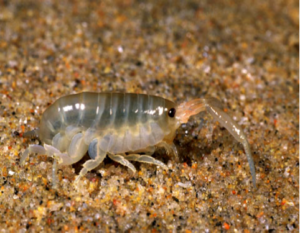Tiny Habitat, Huge Impact!
 As you stroll along Crystal Cove this summer, take a moment to admire all the beauty that can be seen. Rustic historic cottages, gentle waves breaking on the sandy beaches, flocks of shorebirds, or pods of dolphins are sights that are commonly noticed. But, if you keep your eyes peeled, you may uncover wonders in areas that you have yet to explore. With a quick look into a pile of beach wrack, you may discover a whole community you never knew existed!
As you stroll along Crystal Cove this summer, take a moment to admire all the beauty that can be seen. Rustic historic cottages, gentle waves breaking on the sandy beaches, flocks of shorebirds, or pods of dolphins are sights that are commonly noticed. But, if you keep your eyes peeled, you may uncover wonders in areas that you have yet to explore. With a quick look into a pile of beach wrack, you may discover a whole community you never knew existed!
Beach wrack – which is seaweed, driftwood, or other organic materials that washes up on the beach in clusters – is a unique habitat and food source to many inhabitants of our beaches, one of them being beach hoppers.
Beach hoppers are small, beach-dwelling amphipods. They are approximately 1-inch long and are similar in appearance to shrimps (but smaller, flatter, and without the shell). Beach hoppers live in burrows in the sand, often under the beach wrack. This type of habitat offers protection from both drying-out from the sun, as well as wave action from the ocean. Beach hoppers are also known for their remarkable capacity to jump, which is especially interesting given their small body size. Some have been recorded as jumping up to ten times their body length!
Beach hoppers play a vital role in maintaining a healthy sandy beach ecosystem as they are one of the main food sources for many of the shore birds that visit our beaches. They are, however, vulnerable to the removal of their habitat. Often, beach grooming, a process by which beach wrack is removed from the sandy beaches, is performed on public beaches to open up more space for beach recreation. When beaches are groomed, the number of species like the beach hoppers and other organisms living in the beach wrack decline, and in turn, causes a decline in the number of shorebirds that we see on the beach.
Fortunately for us, Crystal Cove State Park’s beaches are not groomed and we are able to experience the interactions between shorebirds, beach hoppers, beach wrack, and other inhabitants on our beach. Next time you are on the beach, take a moment to admire the tiny beach hoppers and how such a small organism can have a huge impact on increasing biodiversity here on our beaches.
